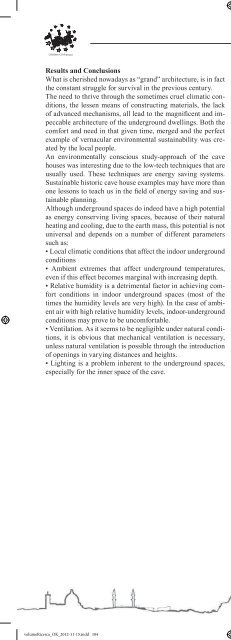habitat rupestre.pdf - Società Friulana di Archeologia
habitat rupestre.pdf - Società Friulana di Archeologia
habitat rupestre.pdf - Società Friulana di Archeologia
You also want an ePaper? Increase the reach of your titles
YUMPU automatically turns print PDFs into web optimized ePapers that Google loves.
UNDERGROUND OR CAVE STRUCTURES IN GREECECRHIMA-CINP projectResults and ConclusionsWhat is cherished nowadays as “grand” architecture, is in factthe constant struggle for survival in the previous century.The need to thrive through the sometimes cruel climatic con<strong>di</strong>tions,the lessen means of constructing materials, the lackof advanced mechanisms, all lead to the magnificent and impeccablearchitecture of the underground dwellings. Both thecomfort and need in that given time, merged and the perfectexample of vernacular environmental sustainability was createdby the local people.An environmentally conscious study-approach of the cavehouses was interesting due to the low-tech techniques that areusually used. These techniques are energy saving systems.Sustainable historic cave house examples may have more thanone lessons to teach us in the field of energy saving and sustainableplanning.Although underground spaces do indeed have a high potentialas energy conserving living spaces, because of their naturalheating and cooling, due to the earth mass, this potential is notuniversal and depends on a number of <strong>di</strong>fferent parameterssuch as:• Local climatic con<strong>di</strong>tions that affect the indoor undergroundcon<strong>di</strong>tions• Ambient extremes that affect underground temperatures,even if this effect becomes marginal with increasing depth.• Relative humi<strong>di</strong>ty is a detrimental factor in achieving comfortcon<strong>di</strong>tions in indoor underground spaces (most of thetimes the humi<strong>di</strong>ty levels are very high). In the case of ambientair with high relative humi<strong>di</strong>ty levels, indoor-undergroundcon<strong>di</strong>tions may prove to be uncomfortable.• Ventilation. As it seems to be negligible under natural con<strong>di</strong>tions,it is obvious that mechanical ventilation is necessary,unless natural ventilation is possible through the introductionof openings in varying <strong>di</strong>stances and heights.• Lighting is a problem inherent to the underground spaces,especially for the inner space of the cave.Notes:1 J. Passas I.,Encyclope<strong>di</strong>an Vocabulary « Ilios» Athens,1976 pp 495-5102 Encyclope<strong>di</strong>an Vocabulary «Elevtheroudakis» Volume 6pp 8293-4-6 http:/www.unige.ch/cuepe/html/plea2006/<strong>pdf</strong>/783_Stasinopoulos.<strong>pdf</strong>5 http://www.greek-islands.us/santorini/cave-houses/7 Underground dwellings and their microclimate under aridcon<strong>di</strong>tions, Isaac Meier ,paper8 W. A. Spaul, ‘Buil<strong>di</strong>ng-related factors to consider in indoorair quality evaluations’ J. Allergy Clin Immunol, August1994.9 J. Namiesnik, T. Gorecki, B. Kozdron-Zabiegala, J. Lukasiak;Indoor Air Quality (IAQ), Pollutants, Their Sourcesand Concentration Levels; Buil<strong>di</strong>ng and Environment;Vol.27, No.3, pp.339-356.1992.10 University of Tennessee Center for Clean Products; Casestudy: Natural Stone Solar Reflectance Index and the UrbanHeat Island Effect; Natural Stone Council; 2009Fig. 17volumeRicerca_OK_2012-11-15.indd 104 16/11/2012 15:02:00
















